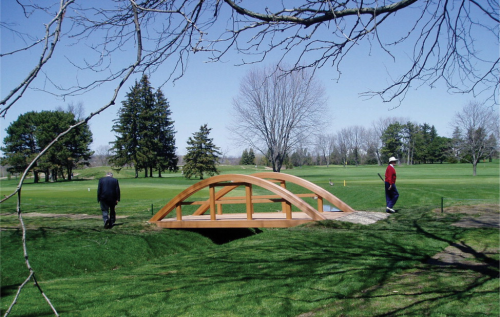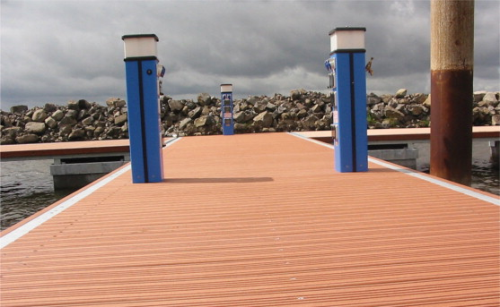



Until recently the term ‘reinforced plastics’ has usually meant glass, carbon, aramid or polyethylene fibres, incorporated in petrol-eum-based resins. However, several factors are now stimulating interest in plant-based fibres and bioplastics for composite manufacture. These factors include the drive for sustainable technology, legislation on the recycling of end-of-life vehicles, and the automotive industry's continuing demands for weight reduction and control of material costs. Plant-based fibres can have considerable reinforcing ability but wood flour (i.e. particles with aspect ratio less than 10) does not usually increase the strength of polyolefins, although it increases their stiffness and hardness and imparts other desirable properties. Plant fibres are widely available from a multitude of sources, although there can be shortages of specific types. The latest (ninth) Conference on Wood and Biofiber Plastic Composites was organised by the US Forest Products Laboratory, the Forest Products Society, and the USDA Forest Service in Madison, Wisconsin, USA, 21-23 May 2007. It attracted 350 delegates, about 50 oral presentations and 42 poster papers. There was also a commercial exhibition.
Natural fibres
Natural fibres are being used increasingly in all countries where composites are manufactured. The cost factor is becoming more favourable and almost all the leading car manufacturers now use plant fibres for several parts. Ford, Opel, Saab and Seat among others use door panels in natural fibres, and Daimler-Chrysler and Opel use natural fibre instrument panels.
One of the biggest problems of plant fibres is their moisture sensitivity and many researchers are trying to overcome this as moisture can damage mechanical properties. Hemp and other fibres contain hemicellulose groups that promote undesirable water absorption, so Stanley Aghedo of Queen's University, Kingston, Ontario, Canada, tried to overcome the problem by pre-treating the hemp in two ways. He then observed the subsequent performance of hemp/recycled linear low density polyethylene (LLDPE) composites. A 20% reduction in moisture uptake during 2000 hours’ immersion was achieved with a hydrothermal treatment, but there was no such benefit by treating the fibres with sodium hydroxide, although it did improve the surface properties. Whether treated or not, the mechanical properties were largely unaffected by eight weeks’ immersion in water, although the authors seemed to imply that longer periods would show a benefit. Kenaf is an interesting plant as it grows about 5 m high in as many months. The elastic and creep properties of the fibres were examined by Yibin Xue from the Center for Advanced Vehicle Systems and other departments of the Mississippi State University, and they found the highest tensile strength (261 MPa) and Young's modulus (20 GPa), although only in the middle of the stalks; the rest was slightly inferior. Ayse Alemdar and co-workers at Toronto University discovered that the defibrillation of pulped wheat straw resulted in nano-sized fibres with improved thermal and mechanical properties. Professor Roger Rowell of the Wisconsin University and US Forest Products Laboratory reported an unusual but very practical project to utilise animal manures as reinforcing fillers for high density polyethylene (HDPE) and polypropylene (PP). The idea was to find new uses for manure from intensive animal farming, an industry which is in danger of being driven out of the USA by protesters motivated by odour problems. Some of the composite samples have a very respectable modulus of elasticity (3.77 MPa) and modulus of rupture (48.6 MPa). (The term modular of rupture is preferred by wood technologists and is roughly equivalent to the polymer technologists' term flexural strength.) The composites have potential uses within the farming sector and the animal production industry. Although all the mixes produced reasonable properties, the best results were reported to have been achieved when the manure was supplied mixed with straw bedding.
Wood plastic composites
WPC has shown fantastic growth in North America. It normally consists of 35-80% by weight of wood flour (or wood fibres, if the aspect ratio exceeds 10) in a polyolefin resin (polyethylene or polypropylene) or polyvinyl chloride (PVC). Demand for similar composites has also mushroomed in Asia, although woodflour is often replaced there by local alternatives such as rice hulls. The European market has been slow to develop, but according to a keynote paper presented by the market analysts Hackwell Group, it is now growing more briskly, with the arrival on the scene of several larger companies such as Deceuninck, Ineos Compounds and the Finland-based paper manufacturer, UPM. Figure 1 shows a WPC pedestrian bridge, also intended for use by golf carts. It was installed in Guelph, Ontario, early in 2007. It was made by Everarch Inc with 30% wood fibre/oriented polypropylene and has a density of 0.55 g/cm3. It measures 20 ft (6.1 m) long and 10 ft (3.05 m) wide. The redwood colour was achieved by mass pigmentation with an inorganic pigment.
Figure 2 shows a Toronto house with a roofing material known as Enviroshake® consisting of a mixture of post industrial plastics, wood fibre and recycled tyre crumb. (Flax, with the longest fibres removed, was used before wood fibres). The roof carries a limited warranty of 50 years and the material has been produced by Wellington Polymer Technology Inc since 2001. The company employs a special additives package to maximise durability.
Figure 3 shows a walkway in WPC at Shannon Cove, Ireland, produced by Earthwood of County Westmeath, Ireland.
Outdoor durability of WPC
WPC is widely used to replace pressure-treated wood in decking in North America. Originally it was marketed as a material to resist outdoor weathering, a low maintenance product with no real need for paint. Its manufacture in complex shapes avoids expensive machining and finishing costs. Experience so far suggests that WPC is vastly better than softwood at resisting deterioration but there have been a few warranty claims and occasional litigation. Snags have arisen because customers were disappointed by minor staining from trees and spillages; regular cleaning became necessary and there was some cracking and checking in hotter climates. Minor changes in formulations and processing technology are already improving performance and there is little doubt that the durability of WPC in temperate climates is very good but some speakers came forward at Madison with more drastic ideas for aggressive conditions. They included using de-lignified wood (or acetylated wood, which has a much lower moisture absorption, according to Rebecca Ibach of the USDA Forest Products Laboratory) or using surface coatings (Sherwin Williams). Marek Gnatowski from Polymer Engineering Co Ltd reported weathering work on polyethylene-based WPC in Florida, Hawaii and Arizona. These regions are all either aggressively hot/wet or aggressively hot/dry. All locations produced deep cracks which became the focus of microbiological attack, depleting the wood. After ten years in Florida, the amount of wood in the surface layer had declined from its original level of about 50 or 55% w/w to as little as 14%. Samples from further inside the samples had wood contents down to 3%. These findings suggest using a biocide. Gnatowski did in fact incorporate zinc borate (ZB) in some of his specimens in addition to a ultraviolet (UV) light stabiliser and it considerably improved the outcome. Rio Tinto, ZB's manufacturer, has reported elsewhere that micro-organisms will grow on WPC surfaces wherever the moisture content reaches 25%. It had previously been thought that such high moisture levels did not occur in WPC but the outermost layer can exceed this level, even in a temperate climate. ZB is not yet approved for use as a biocide for WPC in the European Union, although it is in the USA. There are of course other biocides available and a paper from International Specialty Products described folpet (trichloromethylthiophthalimide), said to be a unique fungicide for WPC.
Mechanical properties
The impact strength and the modulus of WPC both need some improvement. Choice of matrix can affect the outcome. Using PVC instead of polyolefins can give good mechanicals and melamine thermosets (not yet fully developed) are said by (Wood KPlus, Austria) to have potential for more demanding construction applications. (Work on melamine was reported at the Third Wood Fibre Polymer Composites Symposium in Bordeaux, France, in March 2007.) Until recently it has not been possible to process wood with polyamides (PAs) because the wood darkens and degrades above 200°C. Work at the University of Maine by Douglas Gardner has evaluated an amphiphilic processing aid to enable a mixture of PA 6 and PA 66 to be used. This would open the way to under-bonnet applications requiring a higher heat distortion temperature. With 50 parts by weight of wood and 44 of resin, a tensile modulus of elasticity of 4.7 GPa was obtained. Bledski of Kassel University in Germany reported an improvement in the notched impact resistance of wood and biofibre composites by adding man-made fibres such as polyacrylonitrile (PAN) and polyethylene terephthalate (PET). Regenerated cellulose fibres were also tried. The mechanical properties of WPC can be further improved by using the optimum extrusion rate, as found by Karl Englund of Washington State University. Modulus of elasticity (MOE) and of rupture (MOR) of wood/polypropylene both declined at the highest shear rates. Yet another way to improve mechanical properties could be to use a nanoclay filler, as reported by Michigan State University (Omar Faruk and Laurent Matuana). They tried various Cloisite® clays from Southern Clay Products in a wood/polyethylene mix with a maleated polyethylene compatibiliser, but they were chiefly concerned with comparing various processing methods. Nanoclay has been used in foamed WPC by Professor Mohini Sain and his colleagues at Toronto University in Canada. It gives fine cells, but only at low wood contents (25%). Neil Granlund of Alterform, a division of Phillips Plastics, also presented a paper on the foaming process, looking for a correlation between foam structure and mechanical properties.
Cellulose
Ordinary wood contains cellulose, hemicellulose and lignin. Pure alpha cellulose fibres have superior heat resistance (260°C) compared with wood (200°C). Cellulose fibres for automotive uses cost roughly US$1.4-2.0/kg in North America, compared with about $2/kg for glass. The fibres are marketed with aspect ratios of 20-30 by CreaFill Fibers, which claims good light, chemical and heat resistance in a bright white colour, as well as good flexural and impact strength. They bond well to PVC. Cellulose fibres are also produced in nanosized form at STFI-Packforsk AB in Sweden, which starts with bleached sulphite pulp. The energy consumption during the manufacturing process has now been brought down to 1000 kWh/tonne. A single microfibril is about 5 nm wide but nanocellulose fibre widths are between 10 and 30 nm (solid state NMR suggests 17 nm) with a length of 100 nm to 1 μm. There are several forms of strong cellulose. ‘Nanopaper’ is claimed to have a Young's modulus of 10-20 GPa and a stress at break of about 200 MPa. Cellulose whiskers have been researched by Kristiina Oksman and Aji Mathew at Luleâ University in Sweden. The researchers envisage applications in the packaging, medical, automotive and textile industries. The theoretical modulus of a cellulose whisker has been calculated as 167 GPa compared with 73 GPa for glass fibres. The whiskers were obtained from wood and combined with plant-based cellulose acetate butyrate polymer in a twin screw extruder (dispersed in a plasticiser) to give bio-nanocomposites. The whiskers can be aligned in a magnetic field. Optically transparent composites have been manufactured by Japanese scientists at Kyoto University and Mitsubishi Chemical, using bacterial cellulose nanofibres to reinforce epoxy resins. It is possible to make bendable, ultra-thin displays for computers (including wearable computers and pocketbooks) and television sets. Whereas glass/epoxy becomes opaque when the temperature drifts and thus changes the refractive index of the materials, nanocellulose has a very low coefficient of thermal expansion of 0.1 ppm/K. The expansion of the composite is also very low, which is essential for a display. The nanofibres have a modulus of 138 GPa and a tensile strength of 3 GPa. The composites are as strong as steel.
Bioplastics
There is mounting interest in resins from non-petroleum sources. Wisconsin University workers described using polylactide reinforced with fibres made from recycled paper bags and Kassel University reported a flexural strength value for cellulose/polylactic acid composites of 163 MPa with a modulus of 6.2 GPa. The tensile modulus of polylactic acid/ abaca fibre reached 8GPa. Washington State University authors used wood and bamboo as reinforcements for polyhydroxyalkanoates and similar bioplastics, some of which were said to have similar tensile properties to those of polypropylene. In another approach, biodegradable poly(e-caprolactone) was grafted onto cellulose microfibrils by a team from the Royal Institute of Technology at Stockholm in collaboration with the Universidad Pontificia Bolivariana at Medellin in Colombia. The biocomposites industry has a long way to go, but it has reached the stage where several products are being marketed and profits are being made. Mechanical properties will not be a long term obstacle to their success.






